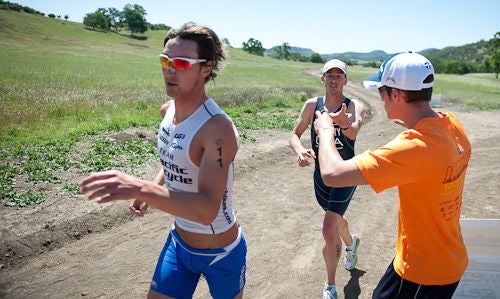Simple Half-Ironman Nutrition Advice

Photo: Nils Nilsen
Matt Fitzgerald provides advice on developing a nutrition attack plan for a half-ironman distance race.
Last summer I received an e-mail from Bob, who was training for his first Ironman 70.3. He asked me how he should plan to fuel himself during the race. In my reply I gave him some advice that I repeat often.
“Keep it simple,” I wrote. “Too many triathletes over-think and overdo their race nutrition.” I told him to drink his favorite sports drink according to his thirst throughout the bike leg and to drink the sports drink offered at fluid stations on the run course according to his thirst as well. That’s it. Anything fancier, I said, would be unlikely to make him go faster and would only increase the risk that he would encounter a self-inflicted issue such as stomach bloating and nausea.
Often I find that triathletes are unreceptive to this guidance, so brainwashed have they been by marketing messages that encourage a complex and heavy-handed approach to race nutrition. But science does not support that approach. For example, in a recent study from the University of Cape Town, South Africa, trained cyclists performed six separate simulated 80-km time trials on stationary bikes while consuming fluid at six rates. Performance was no better when the cyclists drank at a rate sufficient to completely prevent sweating-induced weight loss (the usual recommendation) than when they drank according to their thirst. Drinking rate also had no effect on core body temperature.
During running, athletes naturally replace an even lower percentage of body fluid lost through sweating than they do on the bike when they drink according to their thirst. Due to the jostling that the stomach undergoes during running, it’s not possible to tolerate as much fluid in the stomach, nor absorb it as quickly, as on the bike. And as with cycling, studies have shown that there is no performance or thermoregulatory advantage to be gained from forcing oneself to drink ahead of one’s thirst on the run.
For example, in a study from the Sports Science Institute of South Africa, runners did three separate two-hour runs in the heat while drinking a sports drink at three different rates: By thirst (which amounted to roughly 400 mL per hour), at a moderate scheduled rate of 130 mL every 15 to 20 minutes, and at a high scheduled rate of 300 mL every 15 to 20 minutes. There were no significant differences in core body temperature or finishing times among the three trials. However, during the high drinking-rate trial, two of the eight subjects suffered severe gastrointestinal distress and had to stop running early.
In addition to not overdrinking, you should avoid trying to cram more calories down your throat than you can comfortably stomach when racing an Ironman 70.3. Your body cannot absorb more than roughly 60 grams of carbohydrate per hour during cycling, and even if it can absorb a little more, that extra bit is unlikely to have any additional effect on your performance. In most cases you can easily get the carbohydrate you need to maximize your performance by consuming a sports drink according to your thirst. For example, a typical triathlete may drink roughly 800 mL of fluid per hour by thirst when racing on a warm day. A typical sports drink contains 7.5 grams of carbohydrate per 100 mL. So the triathlete who drinks at this rate will consume 60 grams of carbohydrate per hour along with all the water he or she needs.
A well-formulated sports drink, consumed ad um (as you please), provides all of the nutrition you need to fuel your body through an Ironman 70.3. There’s no need to fool around with water, soft drinks, gels, bars, solid food or electrolyte tablets. That stuff only complicates things.
The only exception I recommend making is in very cool-weather races, when your sweat rate is lower yet your carbohydrate needs remain high. In these situations, consume gels at a rate that’s sufficient to supply your body with 60 grams of carbs per hour and drink water ad libitum.
Bob took my nutrition advice and had a successful first Ironman 70.3 experience. Well, not entirely successful. He did lose a bunch of time due to a rookie mistake that led to a costly bike mechanical. But I hadn’t given him bike advice, so I was off the hook.